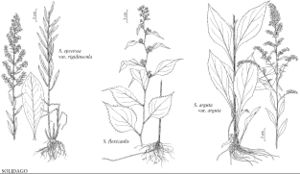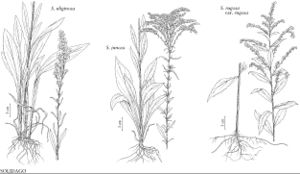Solidago
Sp. Pl. 2: 878. 1753.
Gen. Pl. ed. 5, 374. 1754.
Perennials, 5–100 (–200) cm; woody caudices or rhizomes. Stems decumbent to ascending or erect, sometimes branched distally, glabrous or strigose, strigillose, hispid, or short-villous. Leaves basal (persistent or not by flowering) and cauline; petiolate (proximal) or sessile (proximal and distal, latter sometimes subpetiolate); proximal blades sometimes 3-nerved, ovate-oblanceolate, margins often serrate, faces glabrous or densely hairy; distal sometimes 3-nerved, glabrous or sparsely to densely scabrous, strigillose, or villous, sometimes stipitate-glandular, sometimes resinous. Heads usually radiate, sometimes discoid, (1–) 2–1500+ in racemiform (club-shaped or pyramidal), paniculiform or corymbo-paniculiform, sometimes secund arrays. Involucres campanulate to cylindric (often spreading upon drying), 3–12 × 1.7–10 mm. Phyllaries 10–35 in 3–5 series, midnerves usually ± swollen and translucent, sometimes plus 2–5 secondary nerves (striate, flat), linear-lanceolate to oblong or ovate, unequal to rarely subequal, margins scarious, (apices rounded to acute or attenuate), faces glabrous or sparsely pilose or puberulent, sometimes minutely stipitate-glandular, sometimes resinous. Receptacles slightly convex, pitted, epaleate. Ray-florets (0–) 2–15 (–24), pistillate, fertile; corollas yellow, rarely white (usually glabrous). Disc-florets 2–35 (–60), bisexual, fertile; corollas yellow, ± ampliate, tubes shorter than throats (usually glabrous), lobes 5, erect to spreading, triangular to narrowly lanceolate; style-branch appendages broadly to narrowly triangular (lengths 0.7–1 times stigmatic lines). Cypselae narrowly obconic to cylindric, sometimes somewhat compressed, ribs usually 8–10 (either darker and sometimes translucent or lighter than bodies), glabrous or moderately strigillose; pappi persistent, outer setiform scales (0.25–0.5 mm; rarely present) plus 2 series of 25–45 longer, barbellate bristles, mid apically attenuate, 90–95% length of inner, inner apically weakly to strongly clavate [(0.5–in S. sphacelata) 1.5–5 (–7.3) mm]. x = 9.
Distribution
North America, Mexico, South America, Eurasia
Discussion
Species ca. 100 (77 in the flora).
Solidago is found primarily in North America with some South American and Eurasian species (8 in Mexico, 4 in South America, 6–10 in Europe and Asia).
Recent studies on the phylogeny of Astereae and Solidago have done much to resolve relationships of the goldenrods to each other and to other genera within the tribe (J. J. Zhang 1996; J. C. Semple et al. 1999; R. D. Noyes and L. H. Rieseberg 1999; J. B. Beck et al. 2004). Traditionally the grass-leaved goldenrods, Euthamia, have been included in Solidago; they are well separated within the North American clade. L. C. Anderson and J. B. Creech (1975) presented anatomic reasons for separating the two genera and also Chrysoma, Gundlachia, and Petradoria. The segregate genera Oligoneuron and Brachychaeta fit within Solidago based on anatomy and DNA studies. Brintonia lies outside Solidago based on DNA and morphology. The position of the monophyletic Oreochrysum also appears to lie outside and phylogenetically close to Solidago. G. L. Nesom (1993) placed the flat-topped goldenrods in Oligoneuron. Results from Zhang’s study indicate that the flat-topped goldenrods are nested within other goldenrod groups that Nesom included in Solidago. Beck et al. (2004) indicated that further work is needed before a definitive molecular-based phylogeny is available. While the flat-topped goldenrods are readily distinct from other goldenrods on the basis of arrangements of heads, additional features such as double pappus with clavate inner bristles and oligoneurate phyllaries occur in other species of Solidago as well. The flat-topped goldenrods are treated here as Solidago sect. Ptarmicoidei following Semple and K. N. Gandhi (2004). Nesom provided much of the formal subgeneric nomenclature that by and large is followed here; there are some differences in assignment of species to subsections. Semple (2003, 2004) proposed a number of additional new names and combinations used here. J. L. A. Hood and Semple (2003) presented evidence that the pappus of Solidago is not simple, as previously assumed, but is like that of related genera: it is in two series, inner series somewhat clavate and slightly longer, or sometimes in three series with an additional, shorter outer series of few setiform scales.
Selected References
Lower Taxa
Key
| 1 | Heads usually in ± corymbiform (flat-topped or rounded) arrays, sometimes in glomerules | > 2 |
| 1 | Heads in ± paniculiform or thyrsiform arrays (wand-, club-, or secund cone-shaped) or in axillary clusters | > 3 |
| 2 | Bases of basal leaves not persistent to flowering; heads in round-topped arrays; phyllaries not striate; arctic and alpine habitats, Canada, Alaska, s to California and New Mexico in Western Cordillera, exposed rock outcrops at 1500–2000 m in s Appala-chians | Solidago (sect. Solidago) subsect. Multiradiatae |
| 2 | Bases of basal leaves persistent; heads in flat-topped arrays (somewhat rounded in S. riddellii), sometimes also in glomerules; phyllaries usually striate (except in S. ptarmicoides); Great Plains, Great Lakes region, glades and savannas in e United States | Solidago sect. Ptarmicoidei |
| 3 | Pappi less than 1/4 length of disc corollas; c, se United States | Solidago (sect. Solidago) ser. Brachychaeta |
| 3 | Pappi more than 1/2 length of disc corollas; much of North America | > 4 |
| 4 | Cauline leaves: bases of petioles or blades usually cordate and auriculate-clasping; woods, se United States | Solidago (sect. Solidago) ser. Auriculatae |
| 4 | Cauline leaves: bases of petioles or blades not cordate and auriculate-clasping; various habitats across continent | > 5 |
| 5 | Heads in axillary clusters or in thyrsiform arrays, not nodding or secund at summit nor with recurved, secund branches | > 6 |
| 5 | Heads in paniculiform arrays, nodding or secund distally and/or with proximal branches ± recurved and/or secund | > 10 |
| 6 | Basal and proximalmost cauline leaves usually withering by flowering or relatively small | > 7 |
| 6 | Basal and proximalmost cauline leaves present at flowering and relatively large | > 8 |
| 7 | Phyllaries sparsely to densely stipitate-glandular; leaves sometimes resinous or stipitate-glandular; mid to distal cauline leaves usually petiolate (petioles ca. 1–2 mm) | Solidago (sect. Solidago) subsect. Thyrsiflorae |
| 7 | Phyllaries not stipitate-glandular; leaves not stipitate-glandular or resin-ous; distal cauline leaves sessile | Solidago (sect. Solidago) subsect. Glomeruliflorae |
| 8 | Phyllaries, peduncles, and/or leaves ± viscid (glands minute); mid to dis- tal cauline leaves petiolate | Solidago (sect. Solidago) subsect. Humiles |
| 8 | Phyllaries, peduncles, and leaves usually not viscid (glands on phyllaries in S. villosicarpa); mid to distal cauline leaves sessile | > 9 |
| 9 | Petioles of proximal cauline leaves not sheathing stems, leaves not thick and somewhat fleshy; usually mesic habitats | Solidago (sect. Solidago) subsect. Squarrosae |
| 9 | Petioles of proximal cauline leaves sheathing stems, leaves often thick and somewhat fleshy; bog and marsh habitats | Solidago (sect. Solidago) subsect. Maritimae |
| 10 | Basal and proximalmost cauline leaves present at flowering and relatively large; mid to distal cauline leaves much reduced distally. | > 11 |
| 10 | Basal and proximalmost cauline leaves usually withering by flowering or relatively small; mid to distal cauline leaves gradually reduced distally, similar to proximal | > 14 |
| 11 | Blades of basal and proximal cauline leaves ovate to lanceolate | Solidago (sect. Solidago) ser. Argutae |
| 11 | Blades of basal and proximal cauline leaves lanceolate to linear-lanceolate (basal blades sometimes ovate in S. nemoralis) | > 12 |
| 12 | Petiole bases of proximalmost leaves sheathing stems; plantsof marshes and bogs | Solidago (sect. Solidago) subsect. Maritimae |
| 12 | Petiole bases of proximalmost leaves not sheathing stems; usually mesic to drier habitats | > 13 |
| 13 | Stems and leaves sparsely to densely hairy | Solidago (sect. Solidago) subsect. Nemorales |
| 13 | Stems and leaves usually glabrous | Solidago (sect. Solidago) subsect. Junceae |
| 14 | Plants usually glabrous (even among heads) | Solidago (sect. Solidago) subsect. Junceae |
| 14 | Plants puberulent (at least among heads). | > 15 |
| 15 | Blades of mid cauline leaves reticulate-nerved with multiple prominent lateral nerves abaxially (lateral nerves usually prominent only on proximal cauline leaves in S. fistulosa and S. odora), not 3-nerved, obovate, elliptic, lanceolate, oblanceolate but usually not linear (if linear, anise-scented when crushed) | Solidago (sect. Solidago) subsect. Venosae |
| 15 | Blades of mid cauline leaves usually 3-nerved (lateral nerves sometimes obscured in S. altiplanities, S. leavenworthii, and S. tortifolia, and in some plants of S. lepida from n Rocky Mountains), narrowly to broadly ovate, elliptic, lanceolate, oblanceolate, or linear | > 16 |
| 16 | Blades of mid cauline leaves narrowly to broadly ovate; woods, e Missouri, adjacent Arkansas, Illinois, Kentucky | Solidago (sect. Solidago) ser. Drummondiani |
| 16 | Blades of mid cauline leaves elliptic, lanceolate, oblanceolate, or linear; various habitats across the continent (see also 163a.11. Subsect. Nemorales for plants with only distalcauline leaves present) | Solidago (sect. Solidago) subsect. Triplinerviae |


